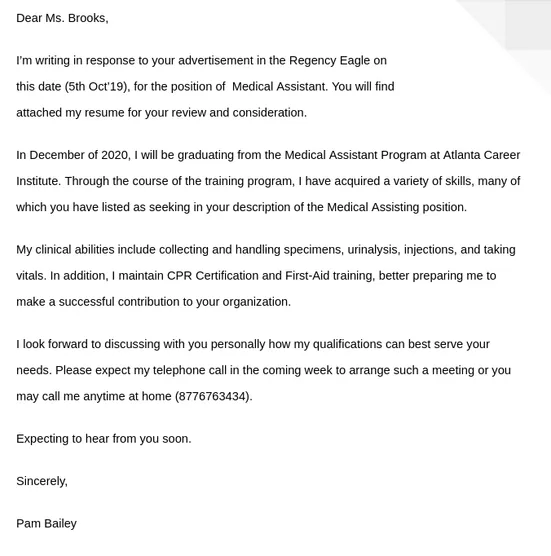What is a Medical Assistant Cover Letter?
A Medical Assistant cover letter is a crucial document that accompanies your resume when applying for medical assistant positions. It serves as your introduction to the hiring manager, providing a snapshot of your qualifications, skills, and experience. Unlike a resume, which lists your accomplishments, a cover letter allows you to explain why you’re the perfect fit for the specific role and company. It’s your opportunity to showcase your personality, enthusiasm, and communication skills, setting you apart from other applicants. When done effectively, a cover letter can significantly increase your chances of securing an interview. Understanding its purpose is the first step in crafting a compelling cover letter.
Why is a Cover Letter Important for Medical Assistants?
In the competitive field of medical assisting, a well-written cover letter is not just a formality; it’s a necessity. It provides context to your resume, allowing you to highlight the specific skills and experiences that align with the job requirements. A cover letter demonstrates your communication skills, attention to detail, and genuine interest in the position and the healthcare organization. It also offers a chance to address any potential gaps in your experience or explain career transitions. Medical assistant roles often involve patient interaction, so a cover letter shows your ability to communicate professionally and persuasively. Without one, you risk being perceived as less prepared or less enthusiastic than other candidates. A strong cover letter increases your chances of getting noticed by the hiring manager, leading to the next step in your job search.
Essential Components of a Medical Assistant Cover Letter
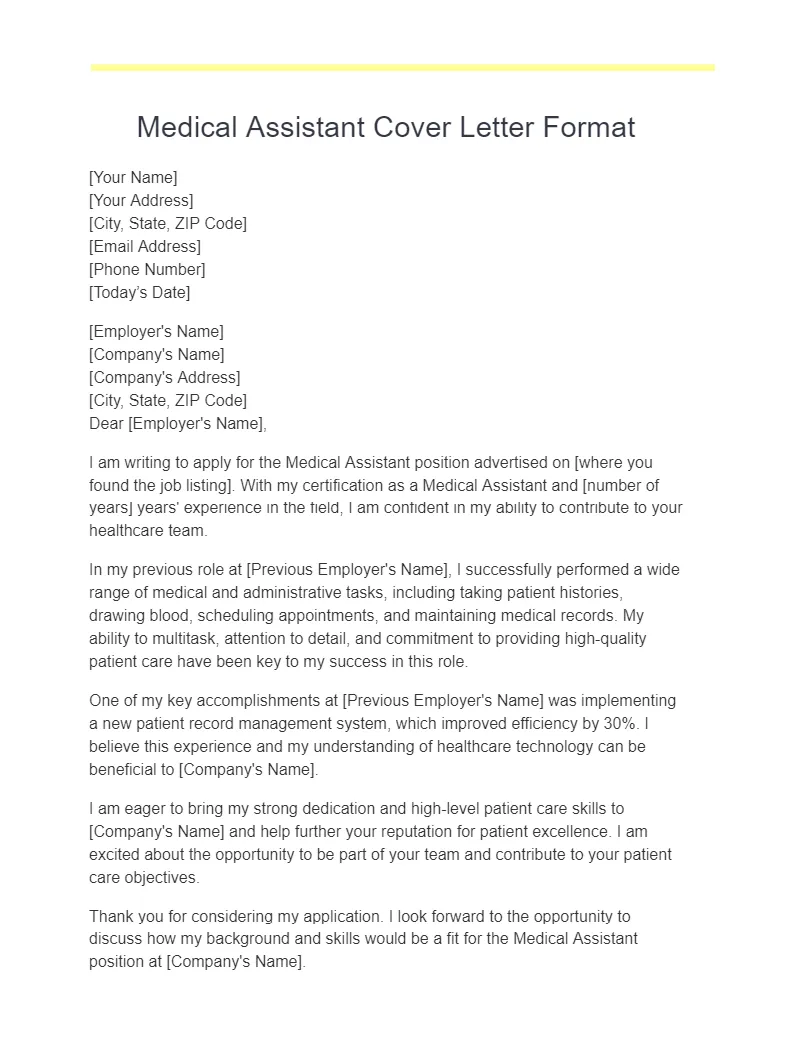
A successful Medical Assistant cover letter comprises several key components that work together to present you as a strong candidate. Including all the necessary elements ensures that you convey a complete picture of your capabilities. From the professional contact information to a compelling call to action, each part plays a significant role in making a positive impression on the hiring manager. Here’s a breakdown of the essential components:
Your Contact Information
Begin your cover letter by providing your full name, address, phone number, and professional email address. This information should be located at the top of the letter, allowing the hiring manager to easily reach you. Ensure that your email address sounds professional (e.g., firstname.lastname@email.com) and that your phone number is current and accessible. This information helps the employer contact you for an interview.
The Hiring Manager’s Contact Information
Research and include the hiring manager’s name, title, and the company’s address. Addressing the letter to a specific person shows that you’ve taken the time to research the company and demonstrates your attention to detail. If the hiring manager’s name is not available, use a professional title like ‘Hiring Manager’ or ‘Recruiting Team.’ This personalized touch can significantly impact the reader and is often viewed favorably by employers.
Salutation that Grabs Attention
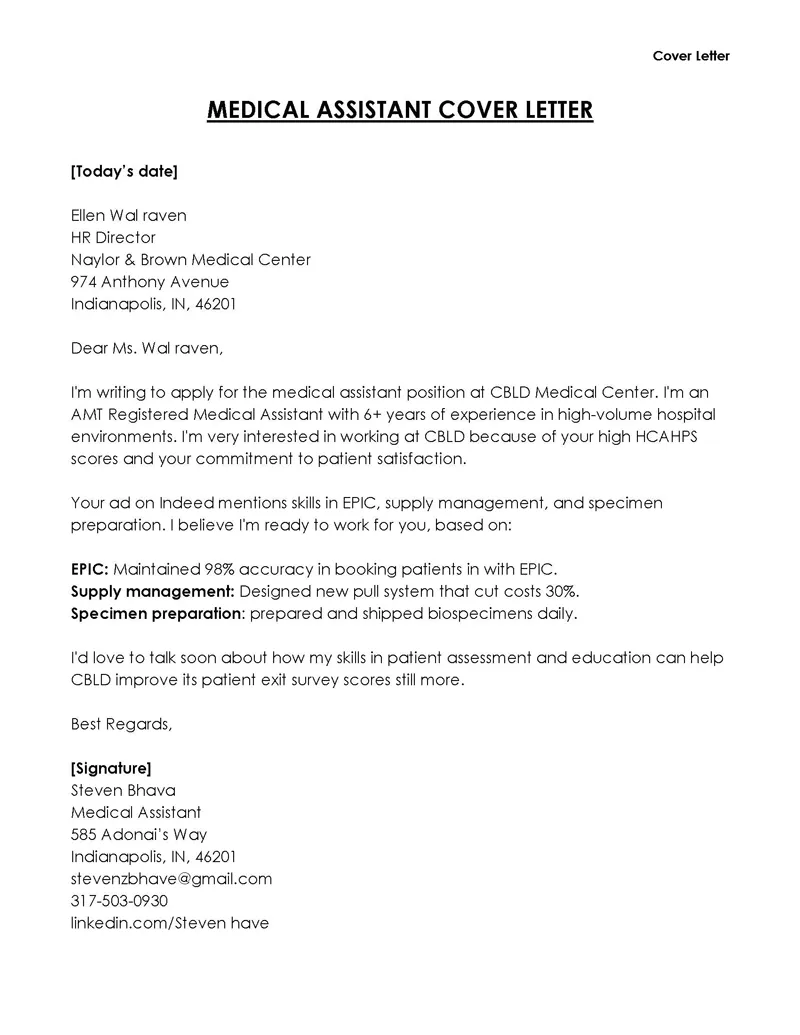
Start your cover letter with a professional salutation, such as ‘Dear Mr./Ms. [Last Name]’ or ‘Dear Hiring Manager’. If you know the hiring manager’s name, use it; otherwise, use a general salutation that is both professional and appropriate. Avoid generic salutations like ‘To Whom It May Concern.’ This sets a positive tone from the beginning and shows that you are addressing the letter to a specific individual.
The Opening Paragraph Captivate Readers
Your opening paragraph should immediately grab the reader’s attention. State the position you are applying for and how you found the job posting. Briefly mention your key qualifications or a compelling achievement that makes you stand out. Express your enthusiasm for the role and the company. Avoid generic statements; instead, provide a clear, concise introduction that highlights your qualifications, so that the hiring manager is immediately intrigued by your candidacy and inspired to read further.
Highlight Your Medical Assistant Skills
In the body of your cover letter, elaborate on the specific skills that make you a great Medical Assistant. Focus on skills directly relevant to the job description. This is where you demonstrate how your abilities match the needs of the employer. Use the STAR method (Situation, Task, Action, Result) to describe your accomplishments with concrete examples. Be specific and provide details to back up your claims, showcasing your ability to perform the duties required for the role.
Emphasize Relevant Experience
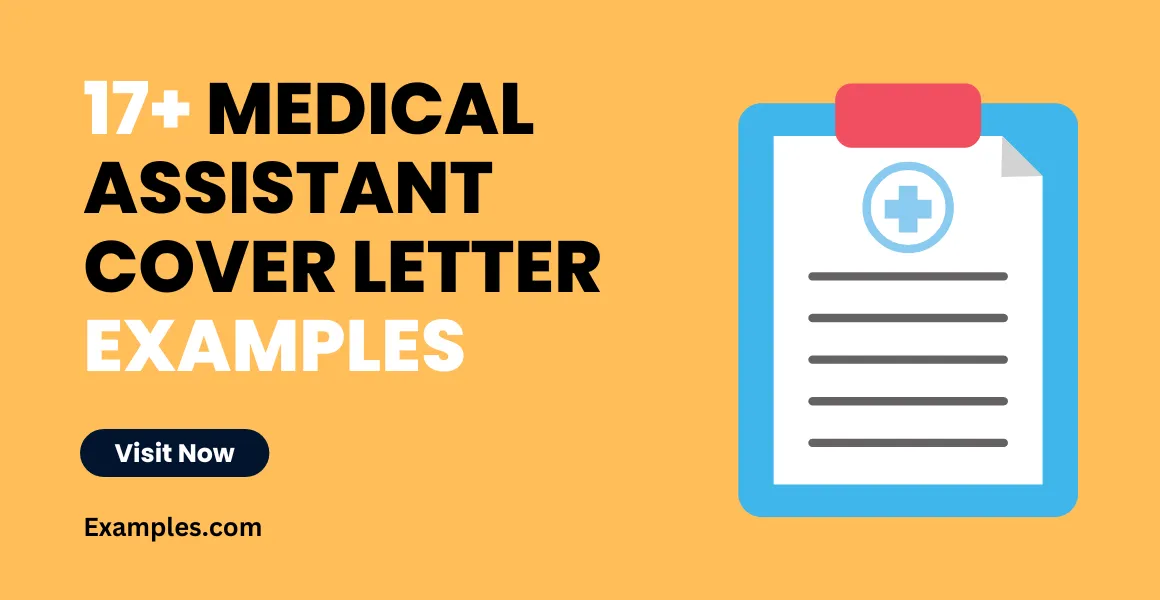
Clearly state your relevant work experience, including the name of the healthcare facility or clinic, your job title, and the dates of employment. Briefly describe your key responsibilities and accomplishments in each role. Highlight any experience with specific medical procedures, electronic health records (EHR) systems, or patient care tasks mentioned in the job description. Quantify your accomplishments whenever possible, such as the number of patients you assisted or the efficiency improvements you achieved.
Showcase Your Soft Skills
Medical assisting is not only about clinical skills; it also requires strong interpersonal skills. Showcase your soft skills, such as communication, empathy, teamwork, problem-solving, and attention to detail. Provide examples of how you have used these skills in previous roles. For example, describe a situation where you successfully resolved a patient complaint or worked effectively as part of a healthcare team. These skills are vital for building trust with patients and ensuring smooth clinical operations.
Quantify Achievements and Results
Whenever possible, use numbers and data to demonstrate the impact of your contributions. This makes your claims more credible and shows the value you can bring to the employer. For example, you can include statistics on how you improved patient satisfaction scores, reduced waiting times, or increased the efficiency of administrative tasks. Quantifiable results can set you apart from other candidates and make your cover letter more compelling.
Express Your Enthusiasm
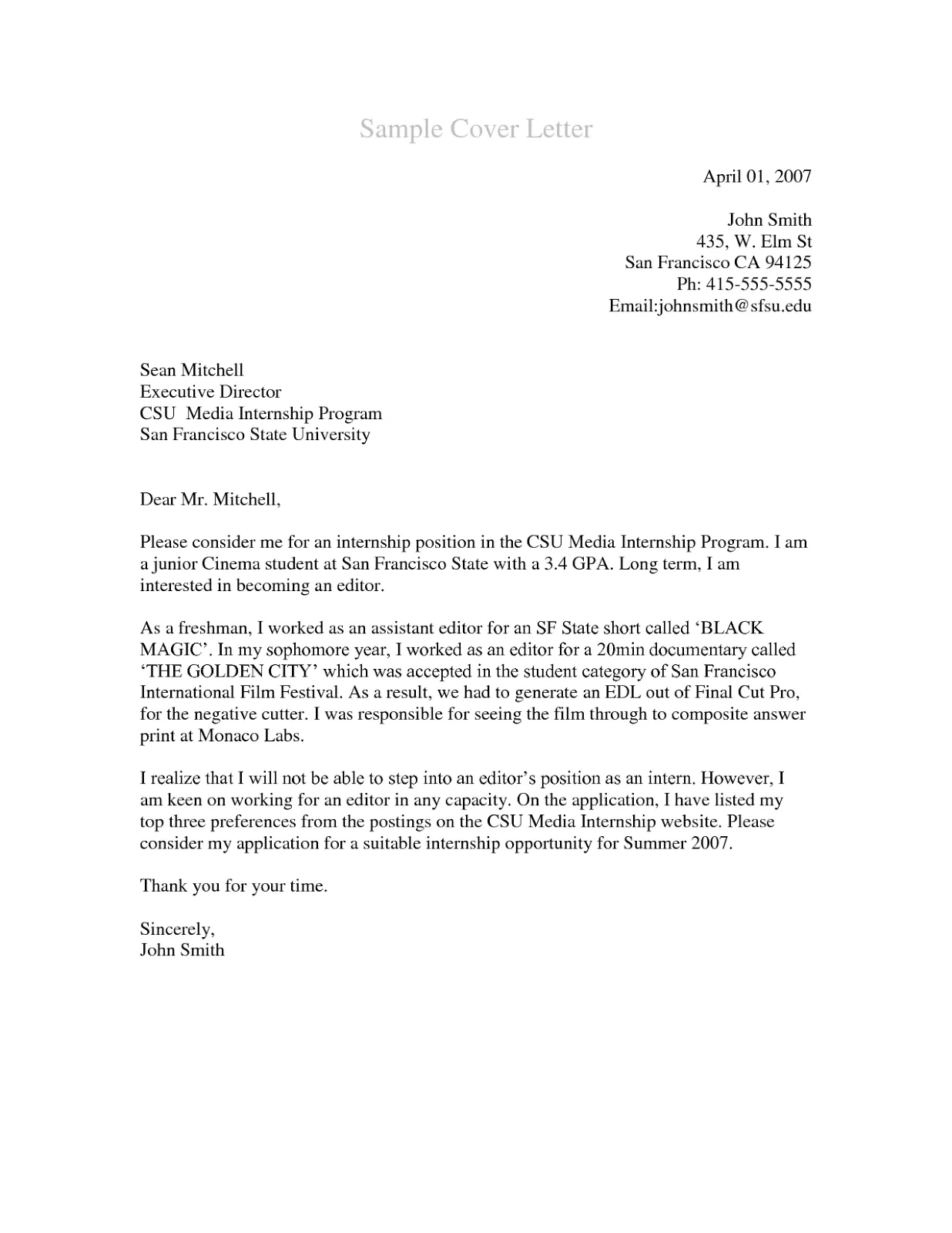
Show genuine enthusiasm for the position and the healthcare organization. Explain why you are interested in working for this specific employer and how your values align with the company’s mission. Mention any research you have done on the organization and how your skills can contribute to their goals. Demonstrate that you are passionate about medical assisting and eager to make a positive impact. Enthusiasm can go a long way in a cover letter and can help create a positive impression.
Call to Action How to Close Your Letter
Conclude your cover letter with a strong call to action. Reiterate your interest in the position and express your willingness to discuss your qualifications further in an interview. Thank the hiring manager for their time and consideration. Include a polite and professional closing, such as ‘Sincerely’ or ‘Best regards,’ followed by your typed name. End on a positive note, reinforcing your eagerness and readiness for the next step in the hiring process.
Proofread and Edit Your Cover Letter
Before submitting your cover letter, carefully proofread it for any errors in grammar, spelling, and punctuation. Ensure that your formatting is consistent and professional. Ask a friend, family member, or career counselor to review your letter for any potential issues. Errors can create a negative impression and undermine your credibility. A polished, well-written cover letter reflects your attention to detail and professionalism. A cover letter filled with errors does the exact opposite. It’s also important to ensure the language is appropriate for the medical field and that the tone matches the healthcare environment. Always maintain professionalism in your writing style.
Cover Letter Formatting Best Practices
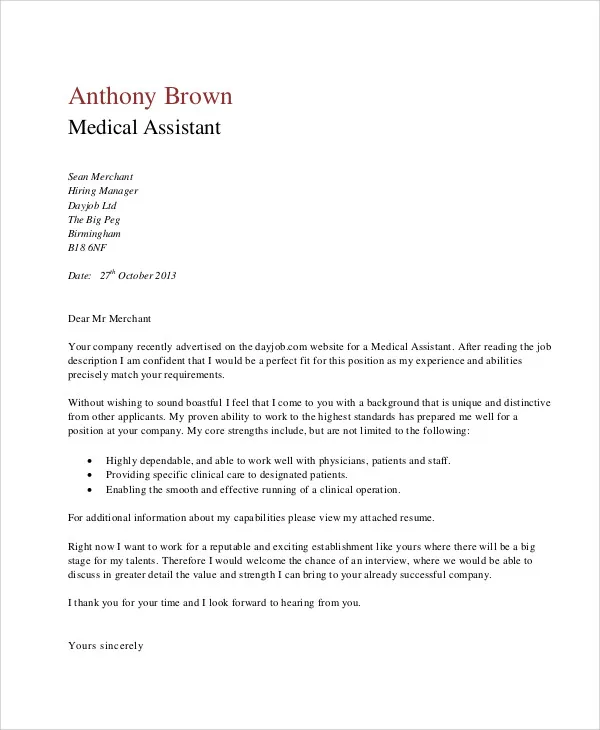
Proper formatting can significantly enhance the readability and professionalism of your cover letter. Following formatting best practices ensures that your letter is easy to read and visually appealing. Proper formatting will help you make the best possible impression on the hiring manager, leading to a positive outcome.
Formatting for Readability
Use a clear, professional font and a standard font size (10-12 points). Use single-spacing within paragraphs and double-spacing between paragraphs. Use left alignment, avoiding full justification. Keep your letter concise and to the point, typically within one page. Use headers, bullets, and white space effectively to break up text and make the information easy to scan and digest. Ensure that your cover letter is well-organized and easy to read to hold the reader’s attention.
Choosing the Right Font
Select a professional and easily readable font, such as Times New Roman, Arial, or Calibri. Avoid using fancy or overly decorative fonts, which can be difficult to read. The font should be clear and easy on the eyes, ensuring the reader can easily focus on your content. The choice of font reflects your attention to detail and professionalism. Use a font that is clean and professional; this will help your letter be visually appealing and easy to read.
File Naming Conventions
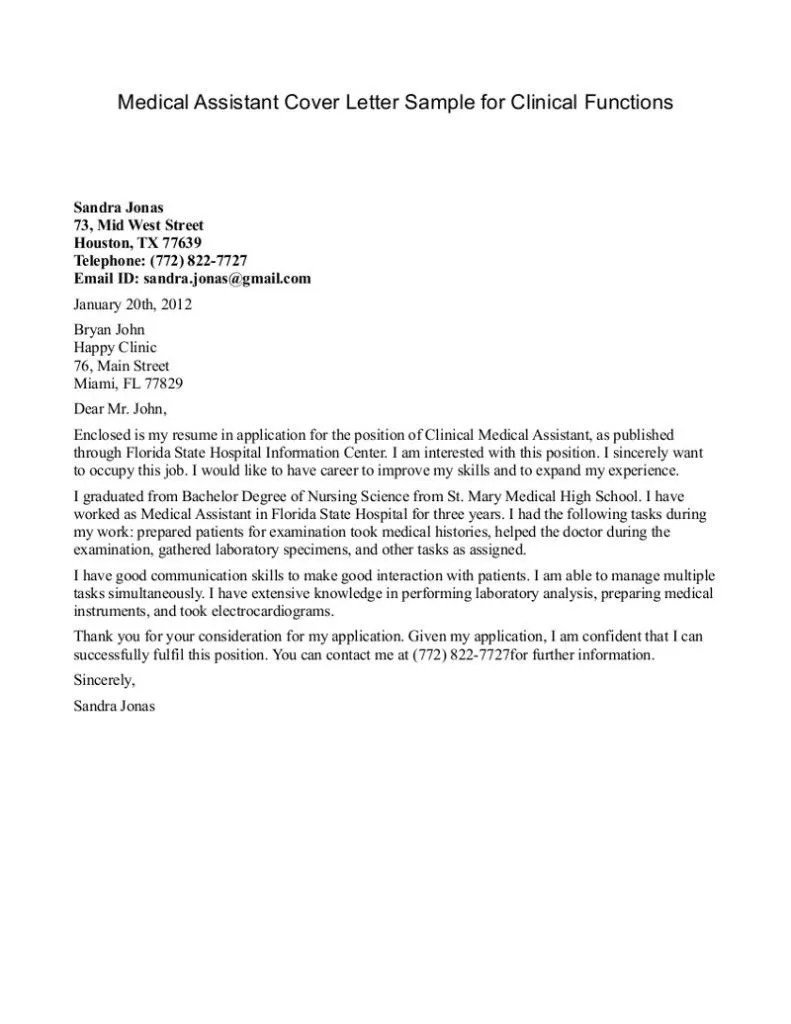
When saving your cover letter, use a clear and professional file name, such as ‘FirstName_LastName_CoverLetter.pdf’. This makes it easy for the hiring manager to identify and manage your application documents. Using a PDF format ensures that your formatting is preserved across different devices. A well-named file demonstrates your attention to detail and professionalism.
Example Medical Assistant Cover Letter
Use the sample cover letter provided as a guide to write your own. Tailor the example to your specific skills, experience, and the requirements of the job posting. Reviewing examples gives you a clear framework for organizing your thoughts and ideas. By customizing the template to your background, you can create a tailored and personalized cover letter.
Here’s a sample cover letter:
Your Name Your Address Your Phone Number Your Email
Date Hiring Manager Name Company Name Company Address
Dear [Hiring Manager Name],
I am writing to express my keen interest in the Medical Assistant position at [Company Name], as advertised on [Platform where you saw the ad]. With [Number] years of experience in patient care and a strong background in clinical and administrative tasks, I am confident that my skills align perfectly with your requirements.
In my previous role at [Previous Employer], I was responsible for [List of responsibilities and achievements, quantifying them if possible]. I am proficient in [List of skills, e.g., taking vital signs, assisting with examinations, managing patient records]. I am also highly skilled in [List of soft skills, e.g., communication, empathy, teamwork].
I am particularly drawn to [Company Name] because of [Mention something specific about the company]. I am eager to contribute my skills and enthusiasm to your team.
Thank you for considering my application. I have attached my resume for your review and welcome the opportunity to discuss my qualifications further in an interview. I can be reached at [Your Phone Number] or [Your Email].
Sincerely, [Your Typed Name]
Key Takeaways
Crafting a successful Medical Assistant cover letter involves understanding its purpose, including the essential components, highlighting your skills and experience, and formatting it correctly. Remember to tailor each letter to the specific job and company, show your enthusiasm, and proofread meticulously. By following these guidelines, you will significantly increase your chances of landing an interview and securing your desired Medical Assistant position. By following these steps, you can make a strong impression and present yourself in the best possible light.
